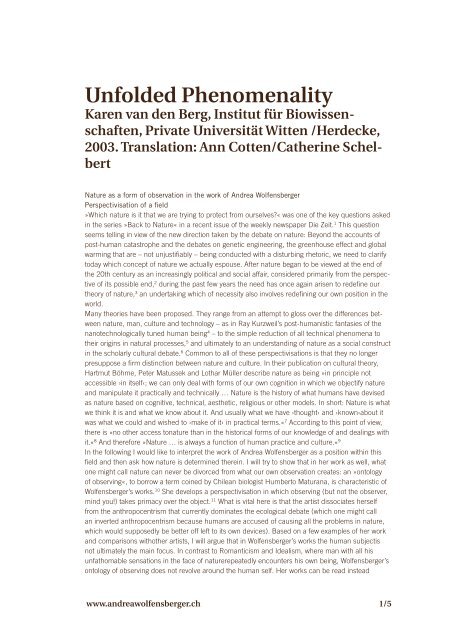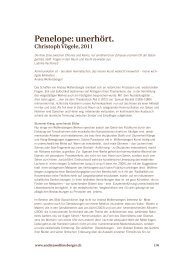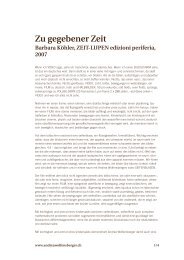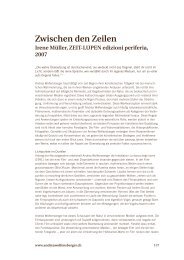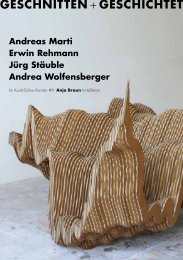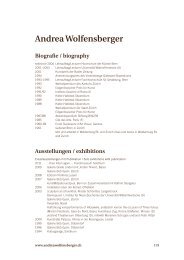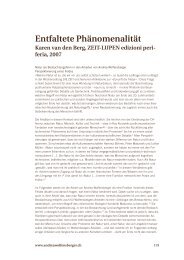Unfolded Phenomenality - andrea wolfensberger
Unfolded Phenomenality - andrea wolfensberger
Unfolded Phenomenality - andrea wolfensberger
Create successful ePaper yourself
Turn your PDF publications into a flip-book with our unique Google optimized e-Paper software.
<strong>Unfolded</strong> <strong>Phenomenality</strong>Karen van den Berg, Institut für Biowissenschaften,Private Universität Witten /Herdecke,2003. Translation: Ann Cotten/Catherine SchelbertNature as a form of observation in the work of Andrea WolfensbergerPerspectivisation of a field»Which nature is it that we are trying to protect from ourselves?« was one of the key questions askedin the series »Back to Nature« in a recent issue of the weekly newspaper Die Zeit. 1 This questionseems telling in view of the new direction taken by the debate on nature: Beyond the accounts ofpost-human catastrophe and the debates on genetic engineering, the greenhouse effect and globalwarming that are – not unjustifiably – being conducted with a disturbing rhetoric, we need to clarifytoday which concept of nature we actually espouse. After nature began to be viewed at the end ofthe 20th century as an increasingly political and social affair, considered primarily from the perspectiveof its possible end, 2 during the past few years the need has once again arisen to redefine ourtheory of nature, 3 an undertaking which of necessity also involves redefining our own position in theworld.Many theories have been proposed. They range from an attempt to gloss over the differences betweennature, man, culture and technology – as in Ray Kurzweil’s post-humanistic fantasies of thenanotechnologically tuned human being 4 – to the simple reduction of all technical phenomena totheir origins in natural processes, 5 and ultimately to an understanding of nature as a social constructin the scholarly cultural debate. 6 Common to all of these perspectivisations is that they no longerpresuppose a firm distinction between nature and culture. In their publication on cultural theory,Hartmut Böhme, Peter Matussek and Lothar Müller describe nature as being »in principle notaccessible ›in itself‹; we can only deal with forms of our own cognition in which we objectify natureand manipulate it practically and technically … Nature is the history of what humans have devisedas nature based on cognitive, technical, aesthetic, religious or other models. In short: Nature is whatwe think it is and what we know about it. And usually what we have ›thought‹ and ›known‹about itwas what we could and wished to ›make of it‹ in practical terms.« 7 According to this point of view,there is »no other access tonature than in the historical forms of our knowledge of and dealings withit.« 8 And therefore »Nature … is always a function of human practice and culture.« 9In the following I would like to interpret the work of Andrea Wolfensberger as a position within thisfield and then ask how nature is determined therein. I will try to show that in her work as well, whatone might call nature can never be divorced from what our own observation creates: an »ontologyof observing«, to borrow a term coined by Chilean biologist Humberto Maturana, is characteristic ofWolfensberger’s works. 10 She develops a perspectivisation in which observing (but not the observer,mind you!) takes primacy over the object. 11 What is vital here is that the artist dissociates herselffrom the anthropocentrism that currently dominates the ecological debate (which one might callan inverted anthropocentrism because humans are accused of causing all the problems in nature,which would supposedly be better off left to its own devices). Based on a few examples of her workand comparisons withother artists, I will argue that in Wolfensberger’s works the human subjectisnot ultimately the main focus. In contrast to Romanticism and Idealism, where man with all hisunfathomable sensations in the face of naturerepeatedly encounters his own being, Wolfensberger’sontology of observing does not revolve around the human self. Her works can be read insteadwww.<strong>andrea</strong><strong>wolfensberger</strong>.ch1/5
man, there by tracing technology and nature back to the same energy processes. Wolfensberger’sagenda is different; she is interested in how her choice of medium may influence her observationof so-called natural phenomena. By virtue of their size – as in the plant curtain and the matchingwall painting at the Kantonalbank – her objects and images are exaggerated to display an enhancedpresent.The accent in Wolfensberger’s work is on providing an arena for observing and dramatisingthe corresponding act of visualisation. This brings ordering patterns and symbolic meanings to light,while the manipulation of time and scale also makes what we see seem unfamiliar.At the same time, Wolfensberger’s pictures of nature eschew self-reflexiveo bservation that discoversin nature only the unfathomable depths of the observing subject – i. e. that which is enigmaticand still indeterminate. Even the series of paintings was uns blüht of 2003 and von den hereinbrechendenRändern of 2006, which were based on video stills the artist took in her mother’s garden,do not offer us spaces on which to project our own agendas. They hint at the tradition and aestheticof nature images that are about the self mourning, its own transience. But the closer one gets toimages like Sternmagnolie, the more wilful they become, rendered in brushstrokes that are anythingbut delicate. In her latest paintings, this technique is exaggerated to the extent that it creates aneffect reminiscent of interference on a TV screen.The beauty of nature is revealed only in potential mode, but even then itis still unsettling. Throughthe deceleration seen in almost all of Wolfensberger’s video works or the device of bringing processesto a standstill and extending the present moment, ordinarily self-evident sequences ofmovementand physical processes suddenly seem deprived of meaningand causality. 18 This isparticularly obvious in the video Bach (Brook), in which the artist seamlessly lines up several digitalblack-and-white photographs of a brook and then pans along them with her camera. We hearsplashing and the picture moves, but the water remains a frozen mass. The media-conditionedgaze generates alienation effects, making the world seem unfamiliar to us and allowing us to see itsphenomena in a new light.In the video YOYO this effect is taken to its logical extremes. The tempo of the film, which shows theartist’s son playing with a yoyo, is reduced to 10 per cent of its original speed. This lends the audiotrack an almost monstrous sound. And the up-and-down movements we associate with the yoyosuddenly appear in a new and totally familiar guise. The childish movements, the social aspect,the interaction with the camera – all that is part of the scene at normal speed – become blurred.Distorting the motion by stretching it out over time creates a completely different reality. The phenomenalityof the action as it unfolds in time implies that the world has a substantiality that we do notperceive, one that is independent of our practices and »ways of worldmaking«. 19 At the same time,however, the blurriness makes us realise that only a media-generated world can reveal this substantiality.Wolfensberger thus reads nature neither as »what’s out there«, as what exists physically, nor asa vision in which nature is, in Böhme’s sense, »always a function of human practice«. In contrast,for example, with the social sculpture of Joseph Beuys, which undoubtedly resonates inWolfensberger’s early works, this oeuvre is not primarily about our responsibility toward, and intellectualinteraction with, natural processes. 20 And unlike Dan Peterman, who in his artistic projectsdeclares the cycle of consumption, decomposition and recycling to be a social issue of utopiandimensions, Andrea Wolfensberger instead exposes above all the phenomenality and temporality ofphysical, chemical and biological processes. She formulates a brittle and at times disturbing sensualityof delay, in which time acquires an almost Heideggerian transcendental quality in exploringthe question of being. By stretching out the present moment and using the tool of deceleration, sherepeatedly draws attention to the phenomenality of the world. In this respect, her works are alwaysabout the primacy of observing as an ongoing creative process, as an effort without which the objectof observation does not make anysense.www.<strong>andrea</strong><strong>wolfensberger</strong>.ch 4/5
1 Elisabeth von Thadden wrotethe first article in the series,wherein she states: »Everyone istalking about ecological collapse.No one talks about nature anymore. This is a mistake.« Cf.Elisabeth von Thadden: »Im Augedes Orkans«, DIE ZEIT, February15, 2007, No. 08, quoted afterthe online version at http://www.zeit.de/2007/08/Klima; retrieved May 1, 2007.2 Bill McKibben, The End of Nature, New York: RandomHouse, 1989.3 One of the major projects undertaken to this end was an interdisciplinary study group on the »Cultural History of Nature« ledby K. M. Meyer-Abich at the Cultural Studies Institute in Essen. Cf. Hans Werner Ingensiep &Richard Hoppe-Sailer (eds.), NaturStücke.Zur Kulturgeschichte der Natur, Ostfildern: edition tertium,1996, and Hans Werner Ingensiep & Anne Eusterschulte(eds.), Philosophie der natürlichen Mitwelt. Grundlagen – Probleme – Perspektiven, Würzburg: Königshausen & Neumann,2002.4 See Ray Kurzweil, The Age of Spiritual Machines: When Computers Exceed Human Intelligence, New York: VikingPress,1999, and Donna Haraway, Simians, Cyborgs and Women: The Reinvention of Nature, esp. chapter 8, »A Cyborg Manifesto:Science, Technology and Socialist-Feminism in the Late TwentiethCentury«, New York: Routledge,1991, pp.149–181.5 The art of Olafur Eliasson provides one example here, as referred to later in the text (see p.173). See Madeleine Grynsztejn,et al., Olafur Eliasson, London: Phaidon, 2002.6 One of the protagonists in the German-speaking world is. See Hartmut Böhme, »Wer sagt, was Leben ist? Die Provokationder Biowissenschaften und die Aufgaben der Kulturwissenschaften«, DIE ZEIT, 49/2000, pp. 41–42, and Hartmut Böhme,Natur und Subjekt, Frankfurt/Main: Suhrkamp,1988.7 Hartmut Böhme, Peter Matussek and Lothar Müller, Orientierung Kulturwissenschaft. Was sie kann, was sie will, Reinbek beiHamburg: Rowohlt, 2000, pp.119–120.8 Ibid., p.120.9 Ibid., p.121.10 See Humberto R. Maturana, Ontology of Observing. The Biological Foundations of Self-Consciousness and the PhysicalDomain of Existence, http://www.inteco.cl/biology/ontology/;retrieved April 1, 2007.11 Ibid., section 12.EVA HESSE Accretion. 1968 Fibreglasseach 147,3 cm, Ø 6,3 cm Rijksmuseum Kröller-Müller, Otterlo ©The Estate of Eva Hesse. Hauser & Wirth Zürich London. From: Bill Barrette (ed.): Eva Hesse Sculpture, Catalogue Raisonné,New York: Timken Publishers 1989, p.182.12 On Eva Hesse, see the extensive documentation by Lucy Lippard in Eva Hesse, New York: New York University Press,1976.13 See the essays by Irene Müller and Sarah Schmidt in this publication, pp.182 and 176.14 Andrea Wolfensberger, Ladanza degli storni, Rome: Istituto Svizzero di Roma, 1991, s. p. Forthe original quotation see:Fritjof Capra, Uncommon Wisdom: Conversations with Remarkable People, New York: Bantam Books,1988, p.140. Here in aninterview Capra says: »I realized immediately that he had put his finger on avery difficult question. I responded by contrastingthe Newtonian view of matter as consisting of basic building blocks, all of which in turnare made of the same materialsubstance, with the Einsteinian view of mass being a form of energy and matter consisting of patterns of energy continuallytransforming themselves into one another. However, I also had to admit that, while it is understood that all energy is a measureof activity, physicists do not have ananswer to the question: What is it that is active?«15 Annette Schindler, »Andrea Wolfensberger«, Sikart. Lexikon und Datenbank des Schweizer Institut für Kunstgeschichte,http://www.sikart.ch/artikel%5C4005833.pdf?PHPSESSID=44bc6f73fece00d1ac4a461e24f8bdf5; retrieved April 1, 2007.16 An allusion to Barnett Newman’s series of paintings Who’s Afraid of Red, Yellow and Blue.17 Rousseau claimed, for example, that taming a pet was to its disadvantage and caused weakness and he regardedcivilisation’s accomplishments as unnecessary, considering »the human in the stateof society» weak and stripped of his»inborn freedom«. See Jean-Jacques Rousseau, Discourse on the Origin and Basis of Inequality Among Men, 1754, quotedafter the online version at http://www.constitution.org/jjr/ineq.htm;retrieved May 30, 2007. Even so, he deemed it out of thequestion for men to return to the »natural state« he envisioned. DAN PETERMAN 61th Street Bottlecap Pasta/Accessoires toan Event. 2001 Pasta, reprocessed post consumerplastic, refrigerator, installationview 2. Berlin biennale, Berlin Photo: Jörgvan den Berg18 A procedure that recalls theearly works of Bill Viola. See David A. Ross and Peter Sellars, Bill Viola, Ostfildern: Hatje/Cantz,2003.19 Independent therefore of a radically constructivist standpoint. See Nelson Goodman, Ways of Worldmaking. Indianapolis:Hackett, 1995.20 See Fernendo Groener & Rose-Maria Kandler (eds.), 7000 Eichen Joseph Beuys. Cologne: Walther König, 1987.21 See Dan Peterman: exh. cat., Kunsthalle Basel/No.17, Basel: Schwabe, 1998.www.<strong>andrea</strong><strong>wolfensberger</strong>.ch 5/5


